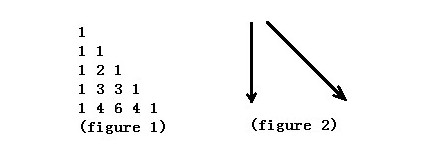DP?
Time Limit: 10000/3000 MS (Java/Others) Memory Limit: 128000/128000 K (Java/Others)Total Submission(s): 2930 Accepted Submission(s): 909

Figure 1 shows the Yang Hui Triangle. We number the row from top to bottom 0,1,2,…and the column from left to right 0,1,2,….If using C(n,k) represents the number of row n, column k. The Yang Hui Triangle has a regular pattern as follows.
C(n,0)=C(n,n)=1 (n ≥ 0)
C(n,k)=C(n-1,k-1)+C(n-1,k) (0<k<n)
Write a program that calculates the minimum sum of numbers passed on a route that starts at the top and ends at row n, column k. Each step can go either straight down or diagonally down to the right like figure 2.
As the answer may be very large, you only need to output the answer mod p which is a prime.
1 1 2 4 2 7
Case #1: 0 Case #2: 5
这题难度太大如果没有对LUCAS和组合数有很好的理解和扎实的基础,建议不要尝试对思维的要求太高
主要的思想就是通过组合数的杨辉三角用一个数和整个序列相加做到优化来消项从而简化计算;
开一个INT数组long long 存不下, 纯lucas模板会超时要打表,这个思想真的很重要,因为P为素数所以打一个10000以内的所有阶乘和阶乘与P的数组
最后还要注意模板中的变量要一一对应,理解每一个变量的含义
情况。考虑从目的地往上走到顶点,因为组合数在k<=n/2是递增的,所以每次只要斜向上
走,到了最左端,再往上走就可以得到最小的和,所以最小的和为
C(n,k)+C(n-1,k-1)+C(n-2,k-2)+……+C(n-k,0)+n-k;
C(n-k+1,0)+C(n-k+1,1)+C(n-k+2,2)+……+C(n-1,k-1)+C(n,k)+n-k
对于组合数有C(n,k)=C(n-1,k-1)+C(n-1,k)
所以最左边两个数相加得 C(n-k+2,1),继续与 C(n-k+2,2)相加得到 C(n-k+3,2),一直加下
去最后得到C(n+1,k)。
所以最小的和为C(n+1,k)+n-k。
#include <iostream>
#include <cstdio>
#include <cstring>
#include <algorithm>
using namespace std;
#define N 10001
typedef long long LL;
int jie[N][N], luc[N][N], visit[N];
int lucas(int n,int m,int p);
int power(int m,int n,int p);
void init();
int main()
{
int n, k, p;
int ncase=1;
init();
while(scanf("%d %d %d",&n, &k, &p)!=EOF)
{
if(n/2>=k)
{
printf("Case #%d: %d\n",ncase++,(lucas(n+1,k,p)+(n-k))%p);
}
else
{
printf("Case #%d: %d\n",ncase++,(lucas(n+1,k+1,p)+k)%p);
}
}
return 0;
}
void init()
{
memset(visit,0,sizeof(visit));
for(int i=2; i<=N; i++)
{
if(!visit[i])
{
for(int j=2*i; j<=N; j+=i)
{
visit[j]=1;
}
jie[i][0]=1, luc[i][0]=1;
for(int j=1; j<i; j++)
{
jie[i][j]=jie[i][j-1]*j%i;
luc[i][j]=power(jie[i][j],i-2,i);
}
}
}
}
int power(int m,int n,int p)
{
int r=1;
while(n)
{
if(n&1)
{
r=r*m%p;
}
m=m*m%p;
n/=2;
}
return r;
}
int lucas(int n,int m,int p)
{
if(m==0)
{
return 1;
}
int ans=1;
int a=n%p,b=m%p;
if(b>a)
{
return 0;
}
ans=jie[p][a]*luc[p][a-b]%p*luc[p][b]%p;
return lucas(n/p,m/p,p)*ans%p;
}





















 1043
1043











 被折叠的 条评论
为什么被折叠?
被折叠的 条评论
为什么被折叠?








